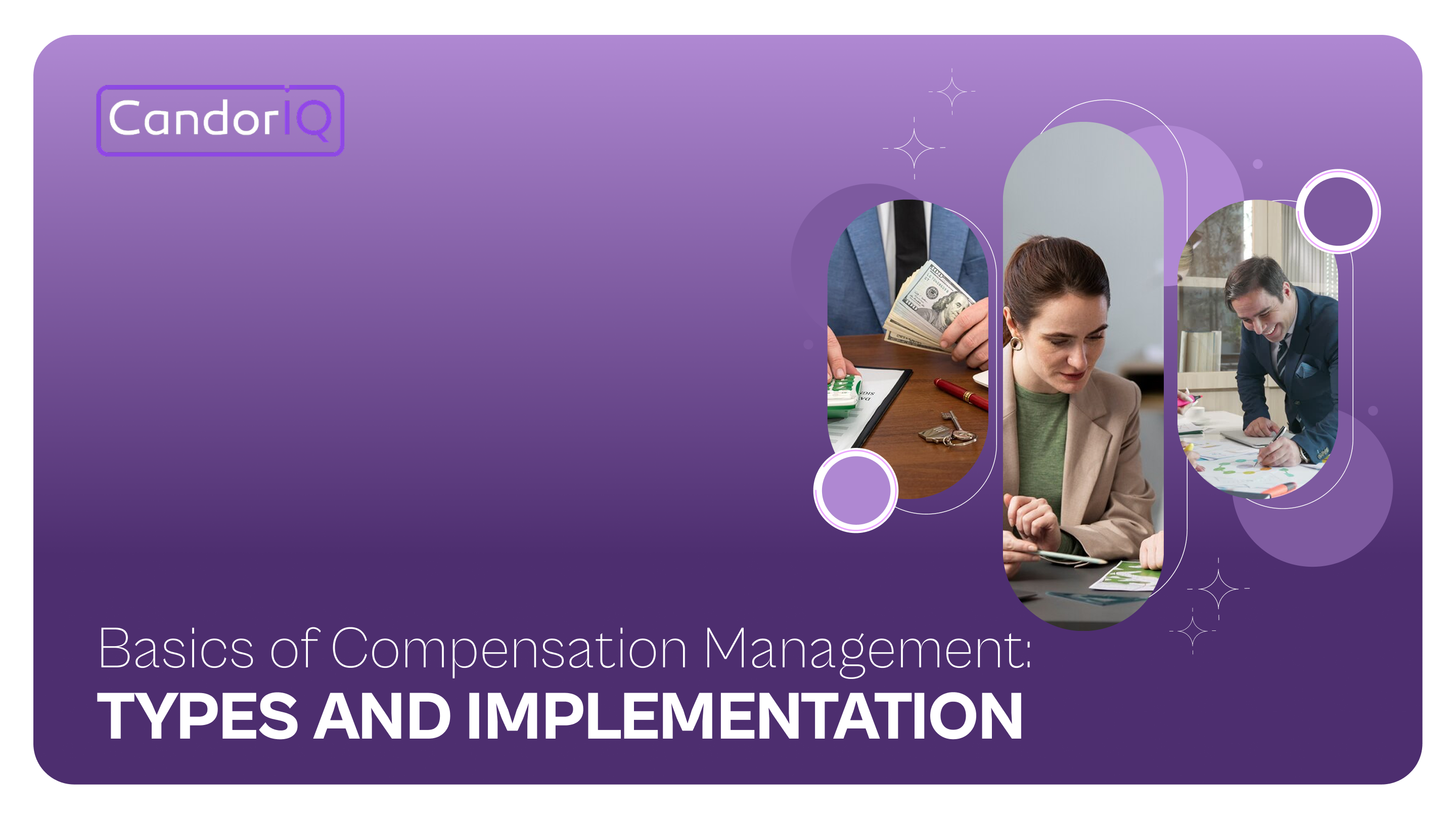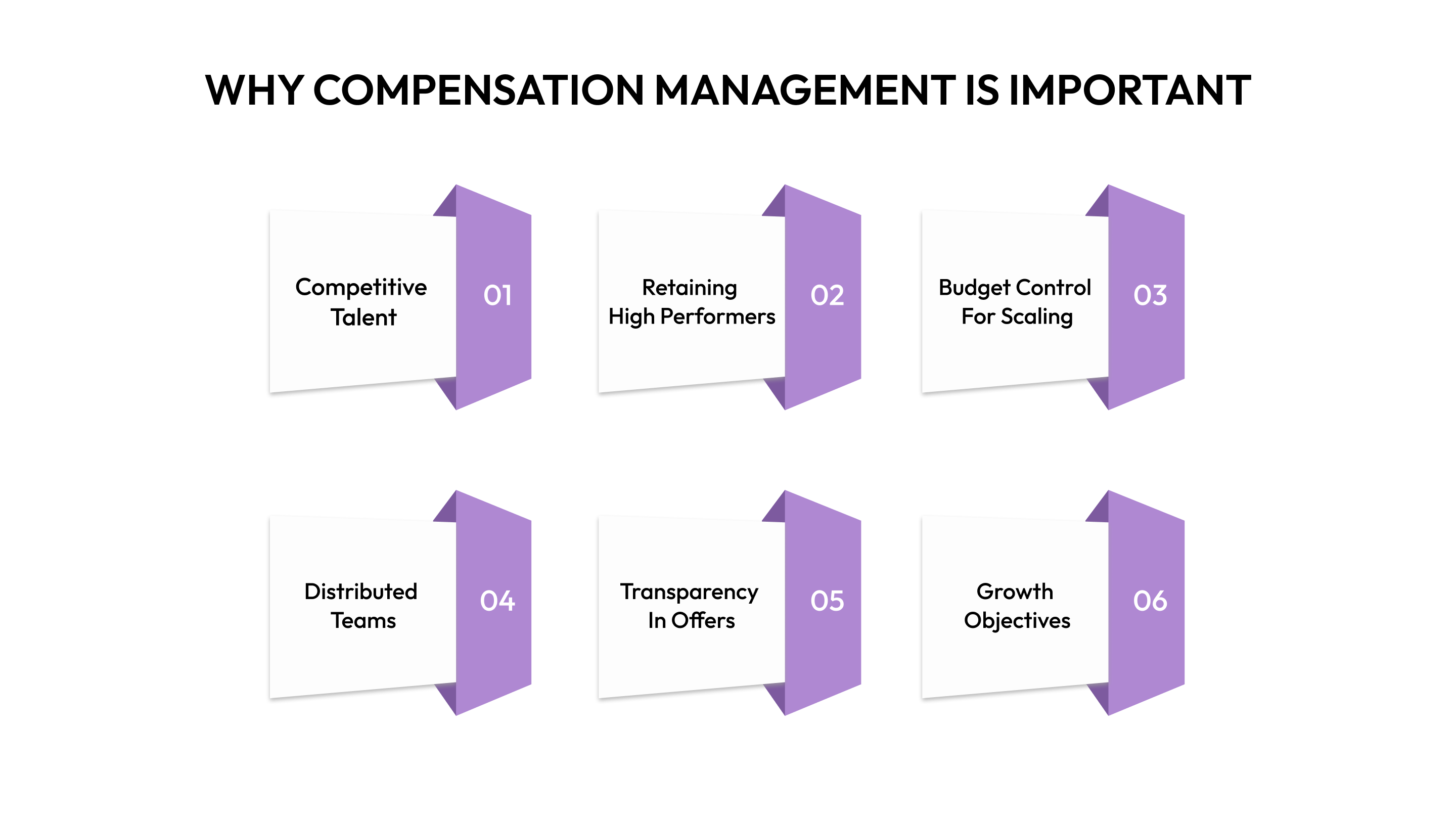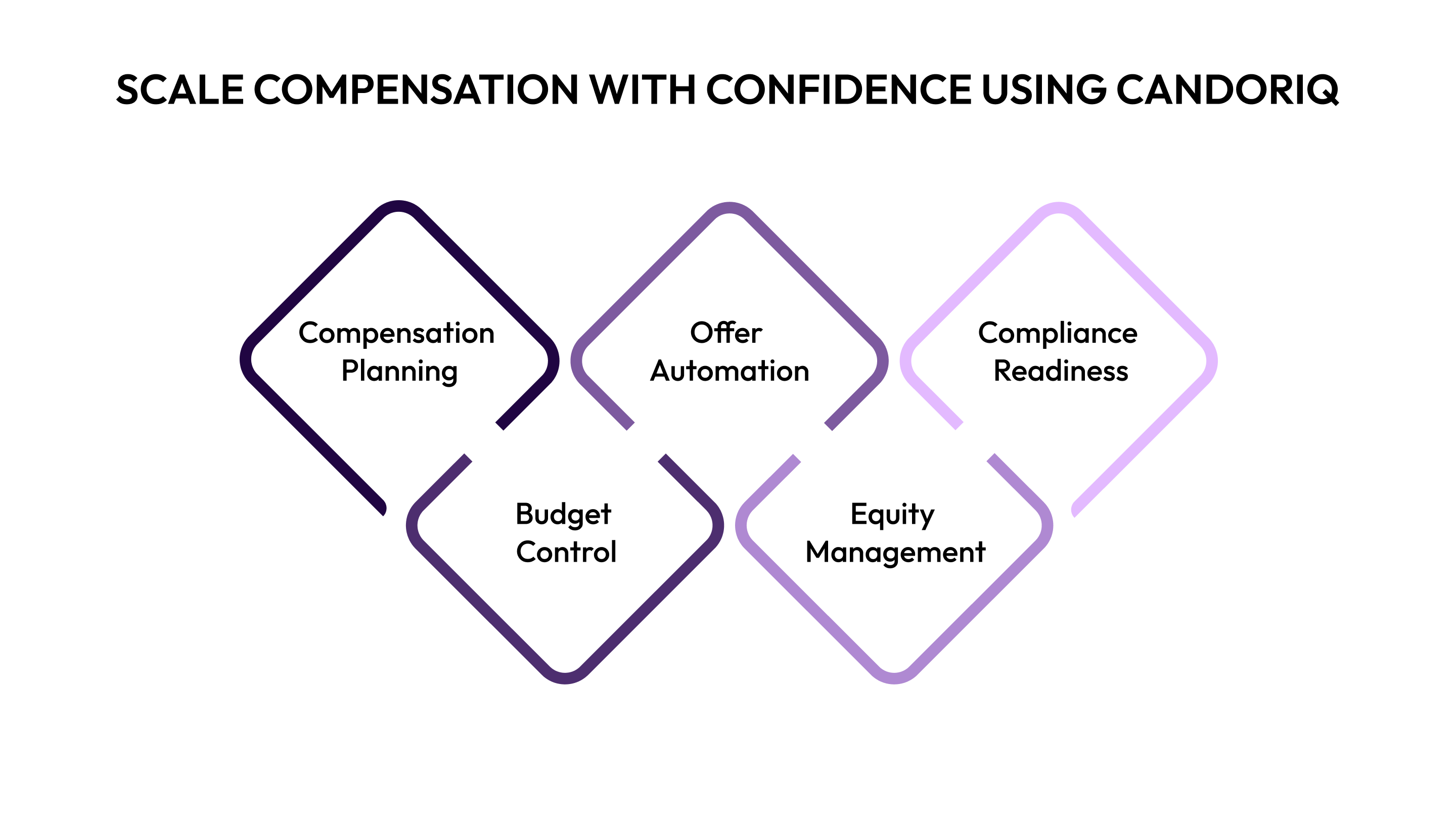Basics of Compensation Management: Types and Implementation
Master the basics of compensation management. Discover how to align pay with market trends, attract top talent, and boost retention. Click to learn more!

Recruiting top talent is tough enough; keeping them is harder when compensation feels inconsistent or unclear. Many growth-stage companies hit a wall here: offers made in a rush, salary bands missing, managers unsure how to explain equity. That confusion chips away at trust and makes scaling chaotic.
This is where the basics of compensation management matter. Getting compensation right isn’t just about payroll; it’s about building structured systems that align with budgets, hiring velocity, and retention goals. HR leaders who focus early on clarity around pay types, equity models, and compliance save themselves from reactive fixes later.
In this guide, we’ll cover the basics of compensation management, break down key types every HR team should know, and share practical steps to embed compensation strategy into daily processes.
Key Takeaways
- Compensation vs. Payroll: Compensation management is strategic, guiding pay structures and growth budgets, while payroll is transactional, handling wages, taxes, and compliance.
- Base pay as foundation: Fixed salaries provide predictability, prevent inequity, and set the groundwork for incentives without unnecessarily inflating costs.
- Equity as a growth tool: Stock options and RSUs conserve cash, align employees with company performance, and drive retention through vesting schedules.
- Software for scale: Compensation management software centralizes pay planning, budgets, and compliance, replacing manual spreadsheets as teams expand.
- Cross-team alignment: Connecting HR, finance, and recruiters on budgets and offers prevents inconsistency, reduces friction, and supports sustainable workforce expansion.
What is Compensation Management?
Compensating employees refers to the structured process of rewarding people for their work through salary, benefits, equity, incentives, or non-monetary rewards.
Compensation management is the strategic practice of designing, administering, and adjusting these pay structures to balance business growth, workforce retention, and financial sustainability.
For mid-sized and growth-stage companies, it means building a consistent framework that supports rapid hiring, market competitiveness, and budget discipline without overextending resources.
Why Compensation Management is Important

Here’s why compensation management holds weight for companies balancing growth, distributed teams, and competitive hiring:
- Attracting competitive talent: A defined compensation management framework allows scaling companies to present market-driven offers that appeal to specialized talent, preventing costly hiring gaps and extended vacancy periods.
- Retaining high performers: Well-structured compensation plans reduce attrition by guaranteeing equity between teams and roles, lowering replacement costs, and protecting institutional knowledge in high-growth environments.
- Budget control for scaling: Compensation management establishes guardrails for salary bands and equity grants, preventing overspending while still supporting aggressive headcount expansion across multiple departments or regions.
- Supporting distributed teams: With employees spread across states or countries, structured pay practices simplify compliance, clarify expectations, and prevent inconsistencies that damage employer brand credibility.
- Transparency in offers: Consistent compensation policies reduce negotiation friction, speed up offer acceptance, and strengthen trust between recruiters, hiring managers, and candidates in competitive hiring markets.
- Alignment with growth objectives: Compensation management assures that pay strategy matches revenue targets and investor expectations, helping CFOs and CPOs balance workforce expansion with sustainable financial models.
Strong compensation practices set the foundation for growth, but to apply them effectively, it helps to distinguish compensation management from payroll, two functions often mistaken for the same.
Want to reduce turnover and keep high performers engaged? Discover the Top Compensation Management Strategies for Employee Retention to strengthen your approach.
How is Compensation Management Different From Payroll?
Payroll keeps money moving; compensation management sets the strategy behind it. One runs payments and compliance, the other shapes pay structures, equity, and growth budgets.
Here’s how they differ across key areas:
Knowing how compensation management differs from payroll makes it easier to look at its key types and how each supports hiring, retention, and budget control.
Looking to bring clarity to pay structures and budgeting? Learn How to Calculate Total Employee Compensation: A Step-by-Step Guide and avoid costly oversights.
Types of Compensation Management and Their Benefits to HR Managers

When companies start scaling, pay practices often get stitched together piecemeal, with one-off salary fixes, reactive bonuses, and uneven perks. Over time, this patchwork creates fairness issues, budget strain, and hiring friction. The basics of compensation management cut through that noise by defining the key types of pay that actually support growth.
Here’s how each type works and why it matters to HR leaders:
1. Base / Fixed Compensation
The guaranteed salary or wage for regular duties, excluding variable incentives. (This is a core part of the basics of compensation management.)
Key Benefits:
- Budget clarity and predictability: Fixed pay allows HR to forecast salary expense reliably against hiring plans and revenue models.
- Internal equity maintenance: Consistent base pay across roles prevents salary inversion and provides fairness across teams.
- Foundation for incentives: With base pay set, variable programs can be layered transparently without overcompensating core work.
2. Variable / Incentive Compensation
Pay that shifts depending on performance, results, or milestones, bonuses, commissions, and profit share.
Key Benefits:
- Performance alignment: Incentive pay directly connects individual or team effort to business outcomes.
- Scalable cost structure: When top-line dips, variable components reduce the cost burden on fixed payroll.
- Retention lever: Long-term incentives (e.g., bonuses, profit share) encourage higher commitment through growth cycles.
3. Equity / Ownership-Based Compensation
Stock options, RSUs, or employee-share plans that grant a stake in company value over time.
Key Benefits:
- Cost-efficient for growth: Equity allows distributing value without immediate cash outflows when budgets are tight.
- Alignment with long-term goals: Employees with ownership incentives care about company performance and valuation.
- Retention via vesting schedules: Vesting periods (e.g., 3–4 years) tie employee tenure to reward realization.
4. Indirect / Benefits & Perks
Non-cash rewards like healthcare, retirement plans, flexible work, PTO, and wellness programs.
Key Benefits:
- Value augmentation without payroll inflation: Benefits enrich total rewards without escalating salary load.
- Differentiation in offer markets: Strong benefits packages (remote support, mental health, equipment) help attract remote talent.
- Support for employer brand: Thoughtful perks reinforce that the company cares beyond pay and motivate engagement.
5. Payment Adjustments & Supplements
Adjustments such as overtime, hazard pay, cost-of-living modifications, or skill premiums.
Key Benefits:
- Legal and operational compliance: Guarantees fair treatment under USA wage laws (e.g., overtime) in distributed teams.
- Targeted compensation pushing: Skill premiums reward high-demand capabilities without shifting the entire base structure.
- Adaptive fairness in local markets: Cost-of-living modifiers allow consistent roles to be compensated for geographic variation.
Understanding the types of compensation management is one thing, but putting them into practice at scale often requires the right software to manage complexity and consistency.
Building comp plans across salary, equity, and perks? Get familiar with the Total Rewards and Compensation Terms You Should Know to avoid confusion and missteps.
What is Compensation Management Software?
Compensation management software helps companies plan, track, and manage pay, covering salaries, equity, bonuses, and benefits, in one platform. Unlike payroll, which processes payments, it focuses on strategy, consistency, and budget impact.
The global market for compensation management software is expected to reach $7.23 billion by 2030, reflecting how widely companies are adopting these tools to manage growth.
Why it matters for scaling companies
- Comp planning: Set salary bands, equity pools, and bonuses tied to hiring forecasts.
- Budget control: Model headcount costs and prevent overspending before approvals.
- Offer automation: Create structured offers quickly while staying within policy.
- Compliance: Maintain fair, compliant pay across states and distributed teams.
For lean HR teams in SaaS, fintech, e-commerce, and pro services, platforms like CandorIQ provide the structure and automation needed to scale compensation with confidence.
How to Smoothly Implement Compensation Management in your HR processes

Many HR teams know compensation matters; the challenge is keeping it structured as headcount grows. Spreadsheets and ad-hoc fixes quickly cause inconsistencies. Grounded in the basics of compensation management, here are five steps to keep scaling smooth:
- Set philosophy and pay structure: Define your compensation approach, then build clear salary bands by role, level, and geography to prevent inconsistencies and pay gaps.
- Integrate equity and incentives early: Design stock and bonus frameworks that scale with growth, avoiding reactive fixes that create inequity or budget strain.
- Connect HR and finance on budgets: Align compensation planning with financial models, giving CPOs, CFOs, and recruiters shared visibility into headcount costs.
- Standardize and automate workflows: Use platforms like CandorIQ to simplify offers, guardrails, and approvals across distributed hiring teams.
- Embed compliance and education: Bake in pay transparency and wage rules, while equipping managers and recruiters to explain compensation consistently to candidates and employees.
Scale Compensation with Confidence using CandorIQ

Compensation often becomes the blind spot in scaling, spreadsheets grow unwieldy, approvals drag, and inconsistent offers create tension. CandorIQ was built to solve this exact problem for mid-sized and growth-stage companies. With a single system, HR, finance, and recruiting teams gain shared clarity on pay structures, equity distribution, and budget impact.
What CandorIQ Delivers
- Compensation planning: Build and manage salary bands, bonus frameworks, and equity pools with full visibility across distributed teams.
- Budget control: Model headcount costs against revenue targets before approvals, keeping growth and financial discipline aligned.
- Offer automation: Generate structured offers instantly, with compliance guardrails built in for multi-state and global hiring.
- Equity management: Track vesting, refresh grants, and equity pools in one dashboard accessible across HR and finance.
- Compliance readiness: Stay ahead of pay transparency and state-specific wage requirements without manual tracking.
Final Thoughts
Pay practices often become disorganized long before leadership realizes the gaps, misaligned salary bands, unclear equity, and inconsistent offers are warning signs. That’s why the basics of compensation management deserve more attention from scaling companies. A structured approach protects hiring velocity, budget discipline, and retention as headcount climbs.
This is where CandorIQ makes a difference. Our platform equips HR, finance, and recruiting teams to design pay ranges, manage equity, track compliance, and forecast costs in one system.

Ready to bring order to compensation without the spreadsheet chaos? Get in touch with us and see it in action.
FAQs About the Basics of Compensation Management
1. How does compensation management differ from payroll processing?
Payroll is transactional, handling paychecks, taxes, and deductions. Compensation management is strategic, defining pay structures, equity plans, and bonus frameworks to balance growth, retention, and budget discipline.
2. Can compensation management address pay transparency laws?
Yes. The basics of compensation management include structured pay ranges and documentation, which support compliance with USA state laws requiring salary disclosures in job postings and internal equity reviews.
3. How early should growth-stage companies formalize compensation structures?
The best time is around 50–100 employees. Without structured salary bands and equity frameworks, inconsistent offers creep in, causing retention and budget challenges as headcount scales.
4. What role does equity play in compensation management?
Equity isn’t just for late-stage companies. In the basics of compensation management, equity pools create retention value, reduce cash pressure, and tie employees to long-term growth outcomes.
5. How can compensation management support distributed teams?
It creates consistency across geographies by applying structured pay bands, cost-of-living adjustments, and compliance rules, reducing risks of inequity or state-level regulatory issues.


